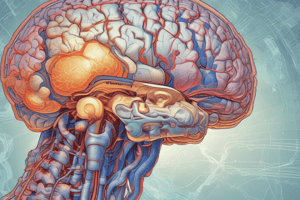Podcast
Questions and Answers
What is the advantage of fMRI scans over PET scans?
What is the advantage of fMRI scans over PET scans?
- fMRI scans do not require the injection of radioactive solutions (correct)
- fMRI scans are less expensive
- fMRI scans are more widely available
- fMRI scans provide more detailed images of the brain
What is the primary function of the somatic nervous system?
What is the primary function of the somatic nervous system?
- Processing sensory information
- Controlling voluntary movement (correct)
- Regulating heart rate and breathing
- Regulating involuntary activities
What is the role of EEG?
What is the role of EEG?
- Measuring blood pressure
- Monitoring heart rate
- Recording changes in electrical activity in the brain (correct)
- Tracking muscle movement
What is the autonomic nervous system responsible for regulating?
What is the autonomic nervous system responsible for regulating?
What is the central nervous system composed of?
What is the central nervous system composed of?
What type of fibers carry information from sensory receptors to the spinal cord and brain?
What type of fibers carry information from sensory receptors to the spinal cord and brain?
What is the function of efferent fibers in the somatic nervous system?
What is the function of efferent fibers in the somatic nervous system?
What is the peripheral nervous system composed of?
What is the peripheral nervous system composed of?
What is the main purpose of using Magnetic Resonance Imaging (MRI) in brain research?
What is the main purpose of using Magnetic Resonance Imaging (MRI) in brain research?
What is the difference between Functional Magnetic Resonance Imaging (fMRI) and Magnetic Resonance Imaging (MRI)?
What is the difference between Functional Magnetic Resonance Imaging (fMRI) and Magnetic Resonance Imaging (MRI)?
What is the purpose of injecting a slightly radioactive solution into the blood during a Positron Emission Tomography (PET) Scan?
What is the purpose of injecting a slightly radioactive solution into the blood during a Positron Emission Tomography (PET) Scan?
What do red and yellow colors indicate in a Positron Emission Tomography (PET) Scan?
What do red and yellow colors indicate in a Positron Emission Tomography (PET) Scan?
What is the commonality between Magnetic Resonance Imaging (MRI) and Functional Magnetic Resonance Imaging (fMRI)?
What is the commonality between Magnetic Resonance Imaging (MRI) and Functional Magnetic Resonance Imaging (fMRI)?
What is the primary use of Electroencephalography (EEG)?
What is the primary use of Electroencephalography (EEG)?
What is the main difference between Positron Emission Tomography (PET) Scan and Magnetic Resonance Imaging (MRI)?
What is the main difference between Positron Emission Tomography (PET) Scan and Magnetic Resonance Imaging (MRI)?
What is the primary goal of cognitive neuroscience approach?
What is the primary goal of cognitive neuroscience approach?
Flashcards are hidden until you start studying
Study Notes
Brain Scanning Techniques
- Cognitive neuroscience approach uses several brain scanning techniques to study the living brain.
- Techniques include Magnetic Resonance Imaging (MRI), Functional Magnetic Resonance Imaging (fMRI), Positron Emission Tomography (PET) Scan, and Electroencephalography (EEG).
Magnetic Resonance Imaging (MRI)
- Involves passing non-harmful radio frequencies through the brain to measure interactions with brain cells.
- Transforms interactions into a detailed image of the brain (or body).
- Used to study the structure of the brain, showing location of structures inside the brain and identifying tumors and sites of brain damage.
Functional Magnetic Resonance Imaging (fMRI)
- Measures changes in activity of specific neurons during cognitive tasks (such as thinking, listening, reading).
- Uses non-harmful radio frequencies and can give detailed views of structures and functions inside the living brain.
- fMRI scans show changes in activity, unlike MRI scans which show structure only.
Positron Emission Tomography (PET) Scan
- Involves injecting a slightly radioactive solution into the blood and measuring the amount of radiation absorbed by neurons.
- Very active neurons absorb more radioactive solution than less active ones.
- Different levels of absorption are represented by colors, with red and yellow indicating maximum activity and blue and green indicating minimal activity.
Electroencephalography (EEG)
- Involves placing many electrodes on the scalp to measure changes in electrical activity at points along the scalp.
- Provides information about brain activity.
Divisions of Nervous System
- The nervous system is divided into Central Nervous System (CNS) and Peripheral Nervous System (PNS).
Central Nervous System (CNS)
- Made up of the brain and spinal cord.
- Spinal cord emerges from the bottom of the brain and carries information back and forth between the brain and the body.
- CNS is the site for complex cognitive functions, such as thinking, speaking, reading, feeling, seeing, and hearing.
Peripheral Nervous System (PNS)
- Made up of all the nerves that extend from the spinal cord.
- Carries messages to and from various muscles, glands, and sense organs located throughout the body.
- Divided into the somatic and autonomic nervous systems.
Somatic Nervous System
- Consists of a network of nerves that connect either to sensory receptors or to muscles that can be moved voluntarily.
- Controls voluntary movement.
- Nerves in the somatic nervous system contain two kinds of fibers: afferent (sensory) fibers and efferent (motor) fibers.
Autonomic Nervous System
- Regulates involuntary activities such as regulating heart rate, breathing, blood pressure, digestion, hormone secretion, and other functions.
- Usually functions without conscious effort.
Studying That Suits You
Use AI to generate personalized quizzes and flashcards to suit your learning preferences.




